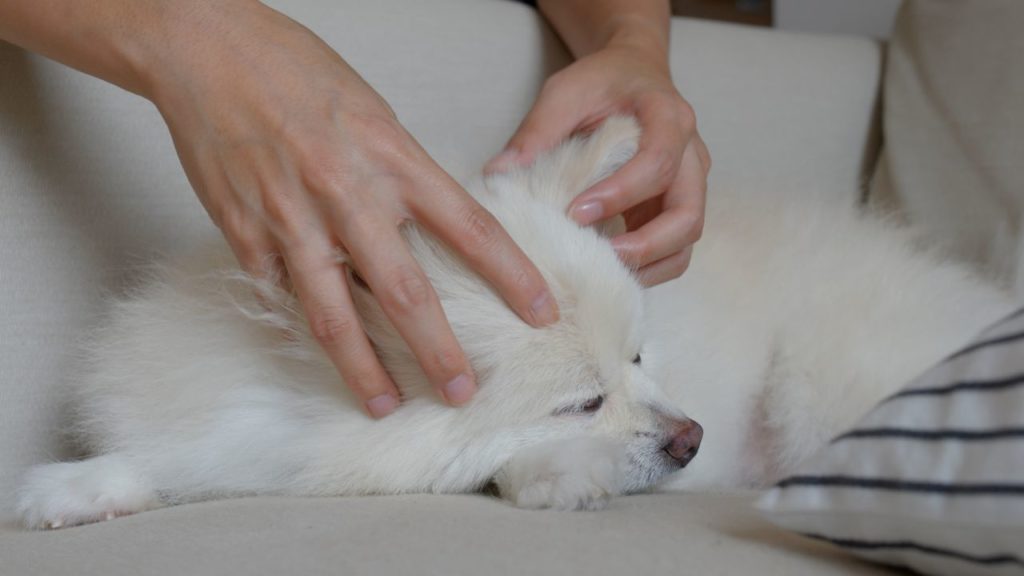Tellington Touch for dogs is a safe type of body work that can decrease anxiety, and possibly increase healing, while strengthening the bond with your dog.
Key Takeaways
- Tellington Touch for dogs, also known as TTouch is a type of body work developed by Linda Tellington Jones in her work with horses.
- To perform the Tellington Touch technique you use your hand to massage small circles all over the body of your pet with varying pressure.
- Tactile therapy for dogs uses physical contact with humans, other animals, or the environment to create an enjoyable, soothing experience for the dog.
- If you want to help calm our dog down with touch focus on areas of the body that are pleasant for them to be pet. This may vary by your dog’s personality and preferences, but many dogs enjoy a gentle stroke on the head, chest, and belly.
- Make sure you pay attention to your dog’s communication. If they yawn, shy away, or start panting the touch may be too intense for them.
Tellington Touch: Gentle, Safe Body Work for Dogs
Tellington Touch also known as TTouch is a type of body work developed by Linda Tellington Jones in her work with horses. It is now used in a variety of animals and one can take training courses online to become proficient at the technique.
The technique uses small circular hand motions all over the body to reduce fear, pain and support healing as per the website.
Benefits/Evidence for Using T-Touch
Tellington Touch is said to decrease pain and stress as well as activate cellular communication. It can be useful in animal training as it can be used to decrease stress thus allowing animals to learn more easily.2
There is little evidence-based research supporting the claims made by the originator, although there is an article showing it was helpful in decreasing stress while training guide dogs, and a research paper showing some reduction in stress in patients getting venipuncture (blood draws).1,3
Although the “hard” evidence is scant regarding Tellington Touch, it is well known that massage can reduce stress and increase positive feelings.4
If your dog enjoys being pet, the gentle stroking, massaging, and touch of this technique will likely be beneficial. It can reduce stress, calm your pet and increase your bond.
When to Not Use
Do not use this technique on an area of your dog that has recently had surgery as it may be painful and compromise the healing incision.
Remember this is a light touch technique, so as long as you do not go too deep and your dog is not showing any signs of discomfort, it will be a positive interaction.
How to Perform Telling Touch on Your Dog
The basis of this technique involves using your hand to massage small circles all over the body of your pet with varying pressure. I will summarize the technique here:
- You want to place your fingers, with a slight curve, and move the skin around in a circle around 1 inch in diameter.
- Each circle should be around a 1 ¼ clockwise rotation. In some cases, a counterclockwise circle can be used.
- Once that area is completed move on to another part of the body.
- It can be done in random locations, or you can move across the body in parallel lines.
- Keep the hand you are not using on the animal’s body in the opposite position to provide support and connection.
The pressure used can vary depending upon how your dog responds. Start with very mild pressure and increase to moderate pressure, similar to how you would massage your temples when you have a headache.
For more details on this technique please see the links below.
https://ttouch.com/about-us/what-is-the-tellington-method/how-to-do-the-ttouch_-/
- Lloyd, Janice and Elizabeth Roe. “Integrating the Tellington TTouch method in guide dog training.” (2012).
- https://ttouch.com/
- Wendler MC. Effects of Tellington touch in healthy adults awaiting venipuncture. Res Nurs Health. 2003;26(1):40-52. doi:10.1002/nur.10065
- Chen Y, Li Q, Zhang Q, Kou J, Zhang Y, Cui H, Wernicke J, Montag C, Becker B, Kendrick KM, Yao S. The Effects of Intranasal Oxytocin on Neural and Behavioral Responses to Social Touch in the Form of Massage. Front Neurosci. 2020 Dec 4;14:589878. doi: 10.3389/fnins.2020.589878. PMID: 33343285; PMCID: PMC7746800.
Topics
Did You Find This Helpful? Share It with Your Pack!
Use the buttons to share what you learned on social media, download a PDF, print this out, or email it to your veterinarian.






